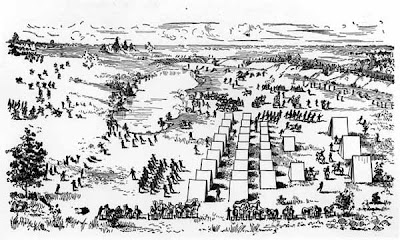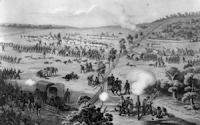 Oliver Loving, one of the great cattle men of Texas and a suplier of beef to the Confederacy, died on September 25th 1867.
Oliver Loving, one of the great cattle men of Texas and a suplier of beef to the Confederacy, died on September 25th 1867.Oliver Loving was born in Hopkins County Kentucky December 4th 1812 the son of Joseph and Susannah Mary (Bourland) Loving , he married in 1833 to Susan Doggett Morgan. He moved his family to Texas in 1843, where he farmed and worked at a teamster. By 1857 he was living in Palo Pinto County Texas and owned 1000 acres of land. Besides land he also had a large herd of cattle, which he quickly found were profitable if driven north. In 1860 Loving drove a herd of 1500 cattle north to Denver Colorado, where miners were in need of meat.
After selling the beef in Denver Loving was ready to return to Texas, however by that time the Civil War had started and he was detained by the Union Army. It was only through the efforts of Colonel Kit Carson and the wealthy Lucien Maxwell, that Loving was set free to return home. Upon getting back to Texas Loving contracted with the Confederate Army to supply them with beef for their troops. When the war ended Loving was still owed about two hundred thousand dollars, for diliverys to the Confederate Army.
After the war Loving met another Texas cattle rancher, Charles Goodnight. The two became close friends and business partners. Selling cattle to the US Army, their trail through New Mexico and Colorado became known as the Goodnight - Loving Trail. In 1867 on a drive north, Loving with a scout Bill Wilson, traveled ahead of the herd to secure government contracts. They ran into a party of Comanche Indians, and in the skirmish Loving was wounded. Loving sent Wilson back for help from Goodnight. Loving managed to evade the Indians for three day, before he flagged down a wagon and was taken into Fort Sumner New Mexico. Loving died from gangrene September 25th 1867. He got a promise from his friend Goodnight to take him back to Texas where he was buried in the Greenwood Cemetery in Weatherford Texas.
Some other interesting web sites about this subject
The Real Lonesome Dove
The Story of Oliver Loving and the Goodnight-Loving Trail










